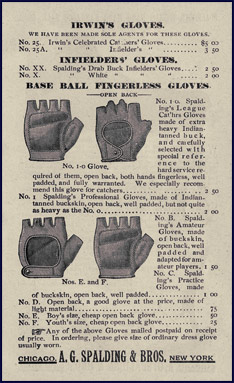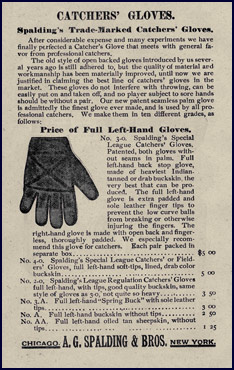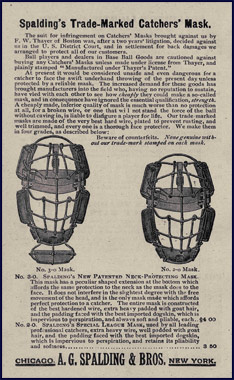Evolution of Baseball Equipment (Continued)
The Uniform

he Knickerbocker Base Ball Club introduced the first "uniform" on April 24, 1849. The uniforms consisted of long blue woolen trousers, leather belts, white flannel shirts with a full collar and straw hats. At the end of the 1850's, many teams adopted the flannel shirt with the button on shield style, which contained the team's emblem, name or both. The full length "pantaloon" pants were in vogue throughout the 1860s but presented a problem of having players getting their feet caught on the legs of the pants when running. Players used to wrap them tight to their shins and use tape or a small belt to hold them flush. The 1868 Cincinnati Red Stockings became the first team to wear knickers. These "cricket-style" pants were less restrictive, and as a result their stockings or socks were now visible. Their red stockings became their trademark.
Many teams required that there players wear ties and usually it was a bow tie. The late 1870s also brought about the laced-front shirt style.
With the emergence of the American Association, the National League made a league wide uniform decision at its annual meeting in Chicago on December 9, 1881. They did not want to be outdone by the new league who instituted a uniform code. Each team was to have multi-hued silk uniforms, with each shirt color representing a position on the field. The National League mandated that all players were to wear white pants, white belts and white ties. The shirts and hats represented the position they played.
- Pitchers - Light Blue
- Catchers - Scarlet
- First Basemen - Scarlet and white vertical stripes
- Second Basemen - Orange and black vertical stripes
- Third Basemen - Blue and white vertical stripes
- Shortstops - Maroon
- Left fielders - White
- Center fielders - Red and black vertical stripes
- Right fielders - Gray
- 1st substitute - Green
- 2nd substitute - Brown
National League team color socks:
- Boston Red Caps- Red
- Buffalo Bisons - Gray
- Chicago White Stockings - White
- Cleveland Blues - Navy
- Detroit Wolverines - Old Gold
- Providence Grays - Light Blue (sky)
- Troy Trojans - Green
- Worcester Ruby Legs - Brown
American Association team color socks:
- Baltimore Orioles - Yellow
- Cincinnati Red Stockings- Red
- Louisville Eclipse - Gray
- Philadelphia Athletics - White
- Pittsburgh Alleghenys - Black
- St. Louis Browns - Brown
This style was extremely confusing to players and patrons and was abandoned in mid-season.
Many teams in the 1880s used the laced-front, full collar shirt, with the name of their city sewn on the front and wore some form of a tie. Pinstripes were introduced in 1888 by three teams, the Washington Nationals and Detroit Wolverines of the National League and the Brooklyn Bridegrooms of the American Association were the pioneers of this style.
Spiked shoes were also used by many players in the 1860s and the shoe plate (cleat), worn under the heel and toe was introduced in the late 1870s. The shoes were usually black, but could be white or white with tan accents.




